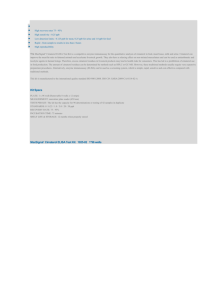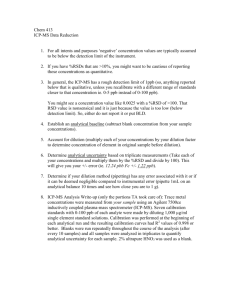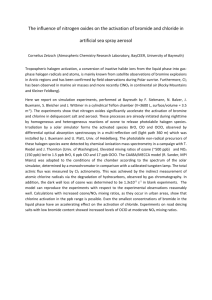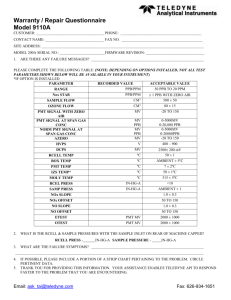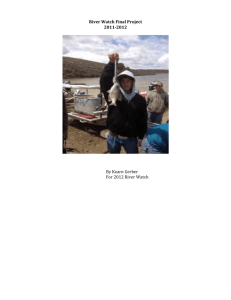Observed regional and urban multi air pollutants
advertisement
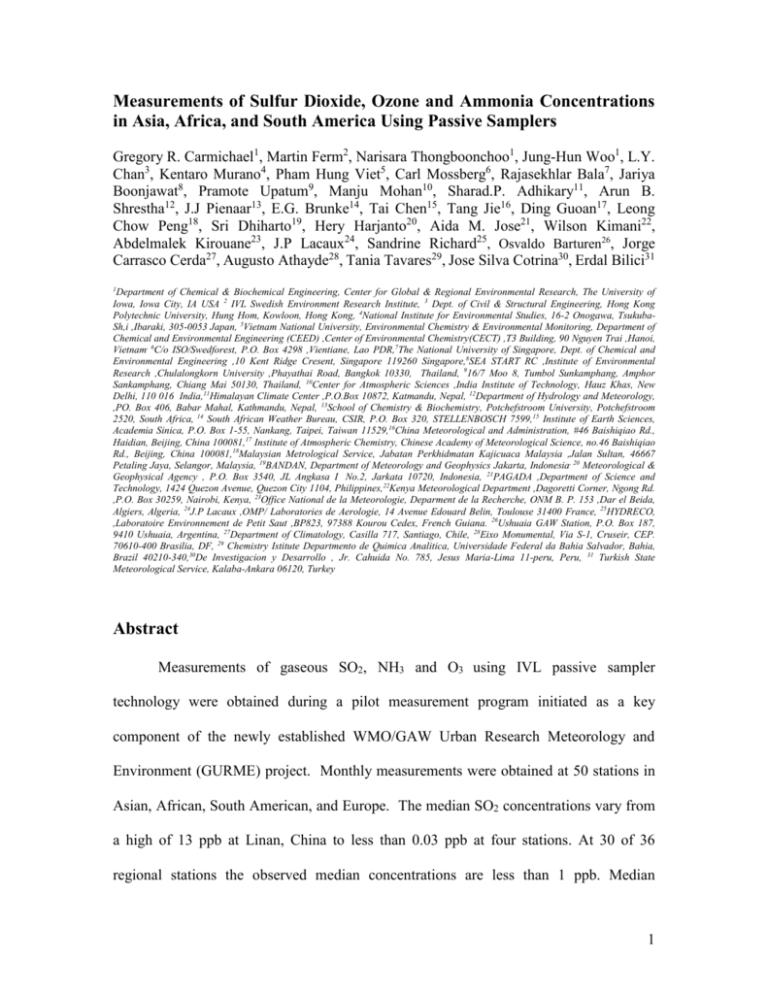
Measurements of Sulfur Dioxide, Ozone and Ammonia Concentrations in Asia, Africa, and South America Using Passive Samplers Gregory R. Carmichael1, Martin Ferm2, Narisara Thongboonchoo1, Jung-Hun Woo1, L.Y. Chan3, Kentaro Murano4, Pham Hung Viet5, Carl Mossberg6, Rajasekhlar Bala7, Jariya Boonjawat8, Pramote Upatum9, Manju Mohan10, Sharad.P. Adhikary11, Arun B. Shrestha12, J.J Pienaar13, E.G. Brunke14, Tai Chen15, Tang Jie16, Ding Guoan17, Leong Chow Peng18, Sri Dhiharto19, Hery Harjanto20, Aida M. Jose21, Wilson Kimani22, Abdelmalek Kirouane23, J.P Lacaux24, Sandrine Richard25, Osvaldo Barturen26, Jorge Carrasco Cerda27, Augusto Athayde28, Tania Tavares29, Jose Silva Cotrina30, Erdal Bilici31 1 Department of Chemical & Biochemical Engineering, Center for Global & Regional Environmental Research, The University of Iowa, Iowa City, IA USA 2 IVL Swedish Environment Research Institute, 3 Dept. of Civil & Structural Engineering, Hong Kong Polytechnic University, Hung Hom, Kowloon, Hong Kong, 4National Institute for Environmental Studies, 16-2 Onogawa, TsukubaSh,i ,Ibaraki, 305-0053 Japan, 5Vietnam National University, Environmental Chemistry & Environmental Monitoring, Department of Chemical and Environmental Engineering (CEED) ,Center of Environmental Chemistry(CECT) ,T3 Building, 90 Nguyen Trai ,Hanoi, Vietnam, 6C/o ISO/Swedforest, P.O. Box 4298 ,Vientiane, Lao PDR,7The National University of Singapore, Dept. of Chemical and Environmental Engineering ,10 Kent Ridge Cresent, Singapore 119260 Singapore,8SEA START RC ,Institute of Environmental Research ,Chulalongkorn University ,Phayathai Road, Bangkok 10330, Thailand, 916/7 Moo 8, Tumbol Sunkamphang, Amphor Sankamphang, Chiang Mai 50130, Thailand, 10Center for Atmospheric Sciences ,India Institute of Technology, Hauz Khas, New Delhi, 110 016 India,11Himalayan Climate Center ,P.O.Box 10872, Katmandu, Nepal, 12Department of Hydrology and Meteorology, ,PO. Box 406, Babar Mahal, Kathmandu, Nepal, 13School of Chemistry & Biochemistry, Potchefstroom University, Potchefstroom 2520, South Africa, 14 South African Weather Bureau, CSIR, P.O. Box 320, STELLENBOSCH 7599,15 Institute of Earth Sciences, Academia Sinica, P.O. Box 1-55, Nankang, Taipei, Taiwan 11529,16China Meteorological and Administration, #46 Baishiqiao Rd., Haidian, Beijing, China 100081,17 Institute of Atmospheric Chemistry, Chinese Academy of Meteorological Science, no.46 Baishiqiao Rd., Beijing, China 100081,18Malaysian Metrological Service, Jabatan Perkhidmatan Kajicuaca Malaysia ,Jalan Sultan, 46667 Petaling Jaya, Selangor, Malaysia, 19BANDAN, Department of Meteorology and Geophysics Jakarta, Indonesia, 20 Meteorological & Geophysical Agency , P.O. Box 3540, JL Angkasa I No.2, Jarkata 10720, Indonesia, 21PAGADA ,Department of Science and Technology, 1424 Quezon Avenue, Quezon City 1104, Philippines,22Kenya Meteorological Department ,Dagoretti Corner, Ngong Rd. ,P.O. Box 30259, Nairobi, Kenya, 23Office National de la Meteorologie, Deparment de la Recherche, ONM B. P. 153 ,Dar el Beida, Algiers, Algeria, 24J.P Lacaux ,OMP/ Laboratories de Aerologie, 14 Avenue Edouard Belin, Toulouse 31400 France, 25HYDRECO, ,Laboratoire Environnement de Petit Saut ,BP823, 97388 Kourou Cedex, French Guiana. 26Ushuaia GAW Station, P.O. Box 187, 9410 Ushuaia, Argentina, 27Department of Climatology, Casilla 717, Santiago, Chile, 28Eixo Monumental, Via S-1, Cruseir, CEP. 70610-400 Brasilia, DF, 29 Chemistry Istitute Departmento de Quimica Analitica, Universidade Federal da Bahia Salvador, Bahia, Brazil 40210-340,30De Investigacion y Desarrollo , Jr. Cahuida No. 785, Jesus Maria-Lima 11-peru, Peru, 31 Turkish State Meteorological Service, Kalaba-Ankara 06120, Turkey Abstract Measurements of gaseous SO2, NH3 and O3 using IVL passive sampler technology were obtained during a pilot measurement program initiated as a key component of the newly established WMO/GAW Urban Research Meteorology and Environment (GURME) project. Monthly measurements were obtained at 50 stations in Asian, African, South American, and Europe. The median SO2 concentrations vary from a high of 13 ppb at Linan, China to less than 0.03 ppb at four stations. At 30 of 36 regional stations the observed median concentrations are less than 1 ppb. Median 1 ammonia concentrations range from 20 ppb at Dhangadi, India to less than 1 ppb at nine stations. At 27 of regional stations, the ambient ammonia levels exceed 1 ppb. The median ozone concentrations vary from a maximum of 45 ppb at Waliguan Mountain, China Japan to 8 ppb in Petit Saut, French Guiana. In general the highest ozone values are found in the mid latitudes, with the Northern hemisphere mid-latitude values exceeding the Southern hemisphere mid-latitude levels, and the lowest values are typically found in the tropical regions. Keywords: diffusive samplers, sulfur dioxide, ammonia, ozone, Asia, Africa, South America 1. Introduction Measurement programs play a critical role in air pollution and atmospheric chemistry studies. Pressures of costs and changing priorities often make it difficult to maintain and expand long terms measurement programs. In some cases environmental planning activities are severely hampered by the lack of information on the ambient levels of pollutants. Such issues are presently being faced by the World Meteorological Organization’s Global Atmospheric Watch (GAW) program. GAW is a coordinated network of observing stations and related facilities whose purpose and long term goals are to provide data, scientific assessments, and other information on changes of the chemical composition and related physical characteristics of the background atmosphere from all parts of the world. This information is needed to improve our understanding of the behavior of the atmosphere and its interactions with oceans and the biosphere and to better anticipate the future states of the earth-atmosphere system. One challenge facing the GAW program is the need to expand its activities to include measurements in each 2 principal climatic zone and each biome, and to continue to add important species to the list of observed parameters. Passive samplers present a means of addressing many measurement issues in air pollution and atmospheric chemistry, in that they provide a cost effective way to monitor specific species at urban, regional and global scales, and offer broad capacity building opportunities. There are a variety of uses for passive samplers in atmospheric chemistry studies. They can be used: a) to increase the spatial resolution of measurements; b) to add species coverage to existing measurement sites; c) to add gas phase measurement to precipitation measurement sites; d) in screening studies to evaluate monitoring site locations; and e) to aid measurement programs by providing a means to increase data completion (e.g., to help keep time series complete during active instrument downtimes). To demonstrate the expanded use of passive samplers in air quality studies a pilot measurement program was initiated as a key component of the newly established WMO/GAW Urban Research Meteorology and Environment (GURME) project. This passive sampler project was done in collaboration and as a component of the IGACDEBITS program. This pilot activity combined components of three separate studies: 1) A pilot study funded by NOAA-US Weather Service, to use passive samplers at selected WMO/GAW stations; 2) A continuation of the use of passive samplers as part of the RAINS-Asia Phase-II funded by the Japan Trust Fund at The World Bank; and 3) A pilot study demonstrating the use of passive sampler at both regional and urban scales, funded by The Swedish Consultancy Fund at The World Bank. 3 The pilot network consisted of stations from previous studies in Asia and from existing GAW stations, along with newly established sites. In total 50 stations in twelve Asian countries (China, India, Indonesia, Japan, Korea, Malaysia, Nepal, Philippines, Singapore, Thailand, Laos and Vietnam), seven African countries (Algeria, Cameroon, Ivory Coast, Niger, Morocco, Kenya and South Africa), five South American countries (Argentina, Brazil, Chile, Peru, and French Guyana) and a European country (Turkey). At these sites sulfur dioxide (SO2), ammonia (NH3 ) and ozone (O3 ) were monitored monthly at the rural sites and with short sampling periods at the urban sites. At the urban sites weekly samples of NO, NO2, HCOOH, CH3COOH, benzene, ethyl benzene, toluene, and xylenes were also obtained. The project aims were: 1) to repeat a previous network for sulfur dioxide (SO2) in Asia; and 2) to extend the capacity to monitor more pollutants in rural as well as urban air. The network provides a valuable data set that can be used for variety of purposes including model evaluation and inter-comparison with other methods. In this paper details and results from the regional network are presented and discussed. The urban results will be the subject of a separate paper. 2. Passive Samplers The samplers used here are passive; but since there are several types of passive samplers, the word diffusive sampler is more specific for these samplers and is more commonly used today. This project has, however, been titled " The Passive Sampler Project". A diffusive sampler has been defined by the European Committee for Standardization as: "A device that is capable of taking samples of gases or vapors from the atmosphere at a rate controlled by a physical process such as gaseous diffusion 4 through a static air layer or a porous material and/or permeation through a membrane, but which does not involve active movement of air through the device". The gas molecules are transported by molecular diffusion, which is a function of air temperature and pressure. A net flux into the sampler is accomplished by placing an efficient sorbent for the target gas behind the barrier. The driving force is the difference between the ambient concentration and the concentration at the sorbent, which should be negligible, compared to the ambient concentration. The average net flux of pollutant through the sampler is obtained by analysis of the sorbent. The resistance of the barrier, as well as the time weighted average ambient concentration, can be calculated using Fick's first law of diffusion. The solution to this equation has been published in almost all articles dealing with diffusive sampling. In order to solve it several prerequisites must be fulfilled. These have not earlier been discussed in connection with the solution of Fick's first law. This is likely the main reason behind a poor quality of some diffusive samplers. The following prerequisites have to be fulfilled to solve Fick’s equation. At steady state the flux (which is obtained from analysis of the sorbent) shall be constant through the sampler implying that the gas is not interacting with the wall or being transformed to another pollutant on its way to the sorbent. This is achieved by choosing an inert wall material and to minimize the residence time by using a short transport distance. The sorption must be quantitative and without interferences. The formed product must be stable. The sorption reaction must not be to slow. The sampler gives a correct average concentration even when the ambient concentration fluctuates and the flux and concentration gradient inside the sampler are not constant. This can be shown from Fick's second law of diffusion and has earlier been treated incorrectly in the literature. Other 5 transports mechanisms than molecular diffusion or permeation must be negligible. Turbulent diffusion, convection and rotation of the sampler can cause an active movement of air inside the sampler. This can be avoided by using a membrane at the inlet, shadow the sampler and during personal monitoring, facing the inlet downwards. Several articles have been written on different parts of the theory behind diffusive sampling, but some parts have been missing. A summary of the published parts and an addition of some missing parts for diffusive samplers using irreversible sorption and a constant cross sectional area (tube or badge type) has recently been published (Ferm, 2001a). A large number of different diffusive samplers for use in outdoor air have been developed since Palmes and Gunnison published a description of the first sampler (Palmes and Gunnison, 1973). Several are today commercially available. The quality of the results from these samplers has varied widely and the technology has therefore occasionally suffered from a bad reputation. This study utilized diffusive samplers developed at IVL. At IVL diffusive samplers for several gases have been developed and described in the literature (Ferm and Rodhe, 1997). They are fully based on these theories implying that the ambient concentration is calculated from the theoretical uptake rate and not from an empirical one. This is to ensure that there are no biases that we are not aware of. The quality does, however, not only depend on the sampler, but also on the analysis, the choice of sampling points, design of network and the evaluation of results. Stevenson et al. (2001) investigated in a laboratory intercomparison the variation between different laboratories for analyses of doped Palmes tubes. They found that the 6 coefficient of variation (a statistical measure of precision based on the difference between duplicate samples) was for most laboratories within ± 25%, which is acceptable for indicative monitoring. In order to use diffusive measurements instead of volumetric or instrumental analyses an analytical precision around ± 5% is needed. At IVL the analytical procedures for the diffusive samplers therefore have been accredited. This implies that certified standards are used and statistical analyses of accuracy and precision of duplicates and reference samples are maintained by the use of control charts every time a batch of samples are analyzed. An analysis of a diffusive sampler has to be performed by personnel accredited for the analyses in question. The laboratory at IVL has to participate in intercomparisons to keep the accreditation. Furthermore, IVL are participating in the standardization work for testing diffusive samplers within CEN (European Committee for Standardization). The IVL samplers are of badge type, 10 mm long and 20 mm internal diameter. A membrane is mounted at the inlet to prevent them from wind-induced turbulent diffusion. The membrane is protected from mechanical damage by a stainless steel mesh. The SO2 and NO2 samplers have been compared to active sampling within a routine network (Ferm and Svanberg 1998). Additional information of the use of IVL-type samplers and their comparison with active sampling results can be found in Ayers et al., (1998), Ayers et al., (2000), Ayers et al., (2002), and Gillett et al., (2000).The NH3 sampler was tested in an intercomparison (Kirchner et al., 1999). The O3 sampler was compared with UVinstrument (Sjöberg et al., 2001). The ozone sampler has also been validated for use in 7 workplace atmospheres (Ferm 2001b). All the samplers are also undergoing intercomparisons within CEN. Sampling The samplers were prepared at IVL and mailed together with instructions to the contact persons in each country. The samplers were mounted under a metal disc ca 3 m above the ground in order to protect them for rain and direct sunshine, see Figure. 1. After one month exposure the samplers were returned to IVL for analysis. Some were not exposed and returned as field blanks. Duplicates were always used. The detection limit was estimated from a sampled amount corresponding to three times the standard deviation of the average field blanks using the actual exposure time. For exactly one month sampling this corresponded to 0.03 (SO2), 1 (NH3) and 0.6 (O3) ppb For the SO2 measurements, 13% were below the detection limit and for NH3 32% were below the detection limit. The upper limit was exceeded for 5% of the NH3 measurements (only in India and Nepal). The upper limit, based on a sampled amount corresponding to half the stoichiometric amount of sorbent and exactly one month sampling, was 32 ppb. In several of these samples the ammonium amount found was equal to the stoichiometric amount of sorbent. In these cases the upper limit was estimated from the sampled amount and the actual exposure time. The coefficient of variation (C o V, a measure of the precision, here it defined as the median relative standard deviation, assuming a normal distribution of the deviation between parallel samples) for all duplicates within the detection limits were: 12%, 20% and 3.6% for SO2, NH3 and O3, respectively. The detection limit divided by the median 8 concentration were 13%, 23% and 3%, respectively. The C o V (calculated in the same way) for SO2 in an earlier test was 10% (Ferm and Rodhe, 1997). The C o V for NH3 was in the earlier test 25% when the membrane was not exchanged with a solid lid after exposure. When the membrane was exchanged, the C o V was improved to 21%. In this study, membranes were changed incorrectly on several occasions. The measured NH3 concentrations can therefore be somewhat over-estimated due to evaporation of NH3 from deposited particulate matter. The C o V for O3 is similar to that earlier observed in Sweden. The accuracy could not be estimated since we did not receive data from parallel measurements using other techniques. Diffusive sampling is a very foolproof technique. There are very few things that can affect the results if the sampling protocol is not followed. The samplers are color marked. Sometimes they were sent back in the wrong storage container. This was noted during the unpacking. At one station blanks and samples were mixed which was easily discovered. The mounting of the rain shield is simple and photos of the mounted equipment have been received from most stations. We therefore believe that the accuracy is similar to that estimated within the accreditation. The average of the duplicates was used here except from very few cases (5 for SO2, 3 for NH3 and 2 for O3) when contamination was suspected. Site information These passive samplers were sent to 50 stations throughout Asia, South America, Africa and Turkey. At the 36 stations representing the regional sites SO2, NH3, and O3 were sampled on a monthly basis. Most sites began measurement in September 1999 and conducted measurements for 12 months. Measurement at some sites started later and/or 9 ran for longer periods. The longest measurement period extended from September 1999 to June 2001. Maps of these sampling sites and station details are presented in Figure 2 and Table 1, respectively. The regional sites were chosen to be representative of rural conditions. Sites were chosen when possible to be away from local sources, including roads. Detailed site information including photographs are available on the project web site (http://www.cgrer.uiowa.edu/people/nthongbo/Passive/passmain.html). 3. Result and discussion A summary of the observed values is presented in Table 2. The number of samples returned, along with the number of samples within the detection limit, is presented. The observed median concentration of SO2, NH3, and O3 obtained at the regional sites are shown in Figures 3,4 and 6, respectively. Shown are the mean, median and maximum and minimum monthly values. The range reflects the strength of the seasonal cycle and will be discussed later. The observed SO2 concentrations (Figure 3) vary from a high of 13 ppb at Linan, China to less than 0.03 ppb at four stations. At 30 of 36 regional stations the observed mean annual concentrations was less than 1.0 ppb. The high concentrations of SO2 at Linan, China, Elandsfontein, S. Africa, Cochin, India, Shang Dian Zhi China, Marcapomacocha, Peru, and Agra, India reflect major contributions from anthropogenic SO2 emissions (i.e., power plant, industrial boilers, heating, and cooking). Most stations show a consistency between the median and mean concentration. The largest disagreements occurred at Cape D’ Aequier, Hong Kong, and Mt. Sto. Tomas, Philippines. At the Hong Kong site this was due to a rusted sampler mesh. Mt. Sto. 10 Tomas levels of SO2 were impacted by the eruption of the Mayon volcano at the end of February 2000 (see Figure 10). Median ammonia concentrations shown in Figure 4 range from 20 ppb at Dhangadi, India to less than 1 ppb at nine stations. At 27 sites, the ambient ammonia levels exceeded 1 ppb. The high median NH3 concentration in the Indian sub-continent, Southeast and South Asia, and Africa reflect high NH3 emissions from agricultural activities (including fertilizer use), livestock, and the use of biofuels (such as animal dung) as domestic fuel. SO2 and ammonia play important roles in aerosol processes, and in influencing the acidity of precipitation. While SO2 has been relatively widely studied, little information is available on ambient NH3 levels for large regions of the World. The ratio of gaseous ammonia to sulfur dioxide provides insight into the relative importance of these species. The ratios of observed ammonia to sulfur dioxide are presented in Figures 5. At 24 sites the ammonia mixing ratios exceed those of SO2, and at 15 sites the ratio exceeds 10. The median ozone concentrations (Figure 6) vary from a maximum of 45 ppb at Waliguan Mountain, China to 8 ppb in Petit Saut, French Guiana. The sorted plot of ozone concentration with latitude (Figure 7) shows that the four stations with the highest ozone levels (Oki, Japan; Waliguan Mountain, Shang Dian Zhi, and Linan, China) are in the Northern Hemisphere mid-latitudes. In general the highest values are found in the mid latitudes of the Northern and Southern hemisphere, with the Northern hemisphere midlatitude values exceeding the Southern hemisphere mid-latitude levels, and with the lowest values typically found in the tropical regions. 11 The observed SO2, NH3 and O3 values in Asia are plotted along with the emissions distributions in Figure 8. In general the observations reflect the spatial distributions of the emissions. SO2 and ammonia are primary pollutants, and both have high emissions around the major urban and industrial centers. However, ammonia emissions are more widespread, reflecting the large contribution due to agricultural activity. Ozone is a secondary pollutant formed by photochemical processes involving NOx and reactive hydrocarbons. High ozone levels are found in regions of high NOx and reactive hydrocarbon emissions as seen at Linan and Cape D’Aequier. But high levels are also found at Waliguan Mountain, reflecting high background levels in the midtroposphere. Time-series of monthly values at selected sites are presented in Figures 9 and 10. The seasonal variation in ambient levels varies from station to station and region-toregion. For example, SO2 in East Asia peaks during the winter season (as illustrated by the data at Linan China), reflecting an increase in emissions associated with domestic heating in China and a decrease in the rate of the gas phase loss of SO2 via chemical conversion to sulfate, and decrease in summer in association with increased precipitation and a shift to on-shore flows. The concentrations in Taiwan and Japan show a similar trend, which may be in part a result of long-range transport of SO2 from China. At Linan, the minimum value in NH3 and O3 occurs in winter. In South Asia, the peak SO2 values occur in winter and spring, and decrease dramatically during the summer monsoon season, reflecting the important role that wet removal plays in influencing the seasonal cycle of ambient SO2 levels. A similar cycle occurs for ozone. However, ammonia does not show as distinct a decrease during the monsoon. The measurements at Chiang Mai, 12 Thailand show a pronounced maximum in all three gases in spring. This reflects the importance of regional scale biomass burning. Distinct seasonal cycles are found at the sites in Africa and South America. These also reflect the interplay between seasonal emissions such as those due to biomass burning, and seasonal meteorological conditions, including dry and wet seasons and major shifts in wind direction. At a few of the measurement sites in Asia SO2 was measured in 1994 using the same passive sampler technique (Carmichael et al. 1995). This allows for a comparison of SO2 levels in 1999/2000 with those in 1994. The results are presented in Figure 11. As illustrated values in Hong Kong and Thailand show a marked decrease, as do the values at Agra. At other India sites the values are either constant or increased (i.e., at Cochin). These differences are consistent with changes in regional SO2 emissions in Asia. In Hong Kong, China and parts of Thailand, sulfur emissions have been declining due in part to a decrease in the sulfur content of fuels. In Agra local efforts to reduce the impact of pollution on the Taj Mahal have lead to closure of many small industrial sources. Further details are discussed in Streets et al., (2002) and Carmichael et al., (2002). 4. Conclusions Measurements of gaseous SO2, NH3 and O3 using IVL passive sampler technology were obtained during a pilot measurement program initiated by the WMO/GAW Urban Research Meteorology and Environment (GURME) project. Monthly measurements were obtained for one year at 50 stations in twelve Asian countries, five African countries, six South American countries, and Turkey. The observed SO2 concentrations varied from a high of 13 ppb at Linan, China to less than 13 0.03 ppb for four stations. At 30 of 36 regional stations the observed mean annual concentrations were less than 1.0 ppb. Annual median ammonia concentrations range from 20 ppb at Dhangadi, India to less than 1 ppb for nine stations. At 27 of regional stations, the samples ambient ammonia levels exceeded 1 ppb. The median ozone concentrations varied from a maximum of 45 ppb at Waliguan Mountain to 8 ppb at Petit Saut, French Guiana. In general the highest ozone values were found in the mid latitudes, with the Northern hemisphere mid-latitude values exceeding the Southern hemisphere mid-latitude levels, and the lowest values were found in the tropical regions. Results from this study help to demonstrate that diffusive samplers are ideal for measurements at remote sites, for checking transport models, screening studies, mapping concentrations in cities, siting of more advanced stations, personal monitoring, etc. The main advantages are: the samplers are small, silent, do not need electricity; the measurements are made in situ (without inlet tubing); the measurement range is very large; technical personnel are not needed at the sampling site; field calibration is not needed; 100% time coverage can be obtained; and they are simple to deploy and mail. The drawbacks are that only gases can be monitored, that the results are not obtained immediately, and peak values of short duration are not resolved. Finally, these results demonstrate that passive sampler offer a low cost means of obtaining high quality measurement, covering large regions while engaging many scientists around the world. 14 Acknowledgements This study was supported in part with funds from the NOAA/US Weather Service through WMO/GAW_GURME project, the Japan Trust Fund at the World Bank as part of RAINS-Asia Part II and The Swedish Consultancy Fund at the World Bank. We also wish to thank all the individuals and institutes who helped make this project a success. 15 References Ayers G.P., Keywood M.D.,Gillet R.W., Manins P.C., Malfroy H. and Bardsley T.(1998) Validation of passive diffusion samplers for SO2 and NO2, Atmos. Environ., 32, 35933609. Ayers G.P., Peng L.C., Fook L., Kong C.W., Gillet R.W. and Manins P.C.(2000) Atmospheric concentrations and deposition of oxides sulfur and nitrogen species at Petaling Jaya, Malaysia, 1993-1998, Tellus B, 52, 60-73. Ayers G.P., Peng L.C., Gillet R.W. and Fook L.(2002) Rainwater composition and acidity at five sites in Malaysia in 1996, Water, Air and Soil Pollution, 133, 15-30. Carmichael G. R., Ferm M., Adikary S., Ahmed J., Mohan M., Hong M-S., Chen L., Fook L., Liu C. M., Soedomo M., Tran G., Suksomsank K., Zhao D., Arndt R. and Chen L. L. (1995) Observed regional distribution of sulfur dioxide in Asia. Water, Air and Soil Pollution 85, 2289-2294. Carmichael G.R., Street D.G, Calori G., Amann M., Jacobson M.Z., Hansen J. and Ueda H.(2002) Environmental Science & Technology(in press). Ferm M. and Rodhe H. (1997). Measurements of air concentrations of SO2, NO2 and NH3 at rural and remote sites in Asia. Journal of Atmospheric Chemistry 27, 17-29. Ferm M. and Svanberg P.A. (1998). Cost-efficient techniques for urban- and background measurements of SO2 and NO2. Atmospheric Environment 32, 1377-1381. Ferm M. (2001a). The theories behind diffusive sampling. Proc. from International Conference Measuring Air Pollutants by Diffusive Sampling, Montpellier, France 26-28 September 2001. 31-40 Ferm M. (2001b). Validation of a diffusive sampler for ozone in workplace atmospheres according to EN838. Proc. from International Conference Measuring Air Pollutants by Diffusive Sampling, Montpellier, France 26-28 September 2001. 298-303. Kirchner M., Braeutigam S., Ferm M., Haas M., Hangartner M., Hofschreuder P. KasperGiebl A., Römmelt H., Striedner J., Terzer W., Thöni L., Werner H. and Zimmerling R. (1999). Field intercomparison of diffusive samplers for measuring ammonia. J. Environmental Monitoring 1, 259-265. Palmes E.D. and Gunnison A.F. (1973). Personal monitoring device for gaseous contaminants. Am. Ind. Hyg. Assoc. J. 34, 78-81. Sjöberg K., Lövblad G., Ferm M., Ulrich E., Cecchini S. and Dalstein L. (2001) Ozone measurements at forest plots using diffusive samplers. Proc. from International 16 Conference Measuring Air Pollutants by Diffusive Sampling, Montpellier, France 26-28 September 2001. 116-123. Stevenson K., Bush T. and Mooney D. (2001) Five years of nitrogen dioxide measurement with diffusion tube samplers at over 1000 sites in the UK. Atmospheric Environment 35, 281-287. 17 Table 1: Station information. Level I means “Regional Station” and Level II means “ Urban/suburban Station” Country Station Location Level Latitude Longitude Elevation (m) China Waliguan mountain 36o17’N 100o54’E 3810.0 I Linan 30o18’N 119o44’E 132.0 I Shang dian Zhi 40o39’N 117o07’E 260.0 I Cape D'Aequier 22o12’N 114o15’E ~1 I Beijing ~40o2’N ~116o25’E ~137 II Wenjiang 30°42'N 103°50'E ~488 II Taiwan Taipei 25o2.55'N 120o30.82'E ~0 II Shui-Li 23o49.1'N 120o50.86'E 330.0 I Japan Oki 36o17’N 133o11’E 90.0 I Malaysia Tanah Rata 04o28’N 101o22’E 1471.6 I Petaling Jaya 03o06’N 101o39’E 45.7 II o ’ o ’ Mersing 02 27 N 103 50 E 44.0 II Lawa Mandau 06o02’N 116o12’E 830.0 I Indonesia Bukit Kototabang 0o12’S 100o19’E 865.0 I Jakarta 6o10’S 106o48’E ~61 II Kalimantan 2o16’S 113o56’E ~0 I Vietnam Hanoi 21o01’N 105o51’E ~122 II Thailand Bangkok 13o45’N 100o32’E 1.0 II Chiang Mai 20o5’N 99o 23’E ~807 I Nakhon Sri Thammarat ~8o15’N ~100oE ~10 I Laos Luang Prabang 19o36’N 101o54’E 640.0 I Vientiane 18oN 102o36’55’’E 200.0 II Savannaketh 16o30’N 106oE 200.0 I Philippines Mt. Sto. Tomas 16oN 120oE 2200.0 I Manila 14o35’N 121oE ~15 II Singapore Singapore 1o16’N 103o51’E ~0 II Nepal Kathmandu 27o42’N 85o22’E ~1524 II Dhangadi 28o41’N 80o36’E ~166 I Nagarkot 27o45’N 85o34’E ~948 I Langtang 28o43’N 85o37’E 15.0 I India Delhi 28o40’N 77o13’E ~213 II Berhampur 20o36’N 84o48’E ~316 I Cochin 9o35’N 76o44’E ~91 I Agra 27o11’N 78o01’E ~175 I Bhubeneswar 20o15’N 85o52’E ~24 I Kenya Mt. Kenya 0oS 37oE 3780.0 I South Africa Elandsfontein 26o15’S 29o25’E 1500.0 I Cape point 34o21’S 18o29’E 230.0 I Algeria Tamanrasset 22o47’N 5o31’E 1377.0 I Niger Banizoumbou 13o32’N 2o04’E 220.0 I Ivory Coast Lamto 6o13’N 5o01’W 136.0 I Cameroon Zoetele 3o15’N 11o53’E 720.0 I French Guiana Petit Saut 5o03’N 53o03’W 50.0 I Argentina Isla Redonda 54o51’S 68° 29'W 3459.0 I Ushuaia 54o49’S 68o19’W 10.0 I Chile El Tololo 30o10’S 70o48’W ~2172 I Brazil Arembepe 12o46’S 38o10’W 0.0 I Peru Marcapomacocha 11°33.7' S 76°27.3' W 4467.0 I o o Turkey Camkoru 32 29'N 40 28'E 1350.0 I Morocco Casablanca ~33o39’N ~7o35’W ~137 II 18 Table 2: Median concentrations in ppb, and number of valid samplers at the sampling sites. Median Median Median Number Number of Number of SO2 NH3 O3 of months SO2 samples NH3 samples (ppb) (ppb) (ppb) with within within returned detection detection samplers* limit # limit # Waliguan mountain 0.26 4 44.9 6 6 6 Linan 13.06 5 38.3 9 9 9 Shang dian Zhi 3.85 3 38.0 9 9 7 Cape D'Aequier 0.64 1 34.9 11 11 5 Shui-Li 0.78 7 25.0 12 12 12 Oki 0.32 <1 40.4 12 12 0 Tanah Rata 0.06 <1 16.0 12 11 3 Lawa Mandau 0.16 <1 17.0 11 11 3 Bukit Kototabang 0.05 3 10.7 7 6 6 Kalimantan 0.11 6 10.2 7 7 7 Chiang Mai 0.07 2 13.7 11 11 11 Nakhon Sri Thammarat 0.14 1 9.2 12 12 8 Luang Prabang 0.03 3 11.2 11 5 11 Savannaketh 0.12 1 15.3 9 7 7 Mt. Sto. Tomas 0.11 2 26.2 9 9 5 Dhangadi 0.21 22 15.2 13 13 11 Nagarkot 0.18 2 33.1 12 11 10 Langtang <0.03 1 32.4 11 2 6 Berhampur 0.40 8 23.7 11 11 11 Cochin 4.77 19 11.8 11 11 8 Agra 1.79 >40 30.8 12 12 0 Bhubeneswar 0.79 7 31.4 22 22 22 Mt. Kenya 0.03 1 30.0 8 4 6 Elandsfontein 6.99 2 35.1 10 10 10 Cape point 0.30 1 24.2 12 12 7 Tamanrasset 0.08 4 33.2 12 12 12 Banizoumbou 0.07 4 25.7 12 8 10 Lamto 0.08 3 14.9 12 8 9 Zoetele <0.03 2 7.2 7 2 6 Petit Saut 0.14 <1 8.4 12 12 0 Isla Redonda <0.03 <1 15.9 4 1 0 Ushuaia <0.03 <1 16.7 7 3 1 El Tololo 0.22 <1 30.6 14 14 1 Arembepe 0.07 <1 19.2 5 4 2 Marcapomacocha 3.09 3 25.1 6 6 5 Camkoru 0.58 <1 35.4 12 12 0 Station * This is the number of months that samplers were returned for analysis. All O3 samplers were within detection limits. Numbers less than 12 indicate problems with getting samplers into and out of the country, and local problem at the sites. # The difference in the number of samplers exposed and the number of valid samplers represents the number of samplers that have mixing ratios that are either above or below the detection limit. 19 Fig. 1. Six diffusive samplers mounted under a metal disc. 20 Figure 2. Location of the measurement sites used in this study (squares and triangles represent regional and urban sites, respectively) 21 Figure 3. Measured SO2 concentrations. The bars indicate maximum, minimum and mean values, and the solid box designates the median values. 22 Figure 4. Measured NH3 concentrations. The bars indicate maximum, minimum and mean values, and the solid box designates the median values. 23 60 0 Dhangadi Banizoumbou Kalimantan Bukit Kototabang Tamanrasset Lamto Mt. Kenya Chiang Mai Mt.Sto. Tomas Luang Prabang Berhampur Waliguan Mountain Nagarkot Nakhon Sri Thammarat Savannaketh Bhubeneswar Shui-Li Cape point Cochin Cape D'Aequier Shang Dian Zhi Marcapomacocha Lin An Elandsfontein NH3/SO2 ratio 100 100 NH3(ppb) 80 10 1 0.1 SO2(ppb) 0.01 0.01 0.1 1 10 100 40 20 Figure 5. Ratios of median NH3 to SO2 concentrations. Insert shows the monthly NH3 and SO2 concentrations. 24 Figure 6. Measured O3 concentrations. The bars indicate maximum, minimum and mean values, and the solid box designates the median values. 25 Figure 7. Latitudinal variation in observed O3. 26 Figure 8a: Observed median SO2 and NH3 in Asia plotted along with the emissions distributions of SO2 (top) and NH3 (bottom). 27 Figure 8b: Observed median O3 values in Asia plotted along with the emissions distribution of NOx (top) and the ratio of Non-methane volatile organic carbon (NMVOC) to NOx ratios (bottom). 28 10 50 20 8 40 15 6 30 10 O3(ppb) 25 NH3(ppb) SO2(ppb) Linan, China 4 5 10 2 0 0 0 Sep-99 Jan-00May-00Sep-00 Jan-01May-01 20 Sep-99 Jan-00May-00Sep-00 Jan-01May-01 Sep-99 Jan-00May-00Sep-00 Jan-01May-01 Bhubeneswar, India NH3(ppb) SO2(ppb) 3 2 20 50 16 40 12 30 O3(ppb) 4 8 20 4 10 1 0 0 0 Sep-99 Jan-00May-00Sep-00 Jan-01May-01 Sep-99 Jan-00May-00Sep-00 Jan-01May-01 Sep-99 Jan-00May-00Sep-00 Jan-01May-01 Chiang Mai, Thailand 0.6 8 40 6 30 O3(ppb) SO2(ppb) NH3(ppb) 0.4 4 20 0.2 10 2 0 0 0 Sep-99 Jan-00May-00Sep-00 Jan-01May-01 Sep-99 Jan-00May-00Sep-00 Jan-01May-01 Sep-99 Jan-00May-00Sep-00 Jan-01May-01 Tamanrasset, Algeria 0.16 8 0.12 6 50 0.08 0.04 O3(ppb) NH3(ppb) SO2(ppb) 40 4 30 20 2 10 0 0 0 Sep-99 Jan-00May-00Sep-00 Jan-01May-01 Sep-99 Jan-00May-00Sep-00 Jan-01May-01 Sep-99 Jan-00May-00Sep-00 Jan-01May-01 Lamto, Ivory Coast 0.2 16 40 12 30 0.08 O3(ppb) 0.12 NH3(ppb) SO2(ppb) 0.16 8 4 20 10 0.04 0 0 Sep-99 Jan-00May-00Sep-00 Jan-01May-01 0 Sep-99 Jan-00May-00Sep-00 Jan-01May-01 Sep-99 Jan-00May-00Sep-00 Jan-01May-01 Figure 9. Seasonal variation in monthly values of SO2 (left), NH3 (middle) and O3 (right) at selected sites. 29 2 50 1.6 40 1.2 30 O3(ppb) SO2(ppb) Camkoru, Turkey 0.8 0.4 20 10 0 0 Sep-99 Jan-00May-00Sep-00 Jan-01May-01 Sep-99 Jan-00May-00Sep-00 Jan-01May-01 0.4 16 0.3 12 O3(ppb) SO2(ppb) Petit Saut, French Guiana 0.2 8 0.1 4 0 0 Sep-99 Jan-00May-00Sep-00 Jan-01May-01 Sep-99 Jan-00May-00Sep-00 Jan-01May-01 El Tololo, Chile 50 0.8 40 30 O3(ppb) SO2(ppb) 0.6 0.4 20 0.2 10 0 0 Sep-99 Jan-00May-00Sep-00 Jan-01May-01 Sep-99 Jan-00May-00Sep-00 Jan-01May-01 0.8 40 0.6 30 O3(ppb) SO2(ppb) Cape Point, S. Africa 0.4 0.2 20 10 0 0 Sep-99 Jan-00May-00Sep-00 Jan-01May-01 Sep-99 Jan-00May-00Sep-00 Jan-01May-01 Mt. Sto. Tomas, Philippines 10 40 30 O3(ppb) SO2(ppb) 1 20 0.1 10 0.01 0 Sep-99 Jan-00May-00Sep-00 Jan-01May-01 Sep-99 Jan-00May-00Sep-00 Jan-01May-01 Figure 10. Seasonal variation in monthly values of SO2 (left), and O3 (right) at selected sites 30 6 '94 '99-00 SO2 concentration( ppb 5 4 3 2 1 Ag ra C oc hi n C ap e D 'A eq ui er Ta na h R at La ta wa M an da u Su ra th an i C hi an g ra i D ha ng ad i Be rh am pu r 0 Station Figure 11. Changes in annual median SO2 concentrations between 1994 and 1999/2000 31
